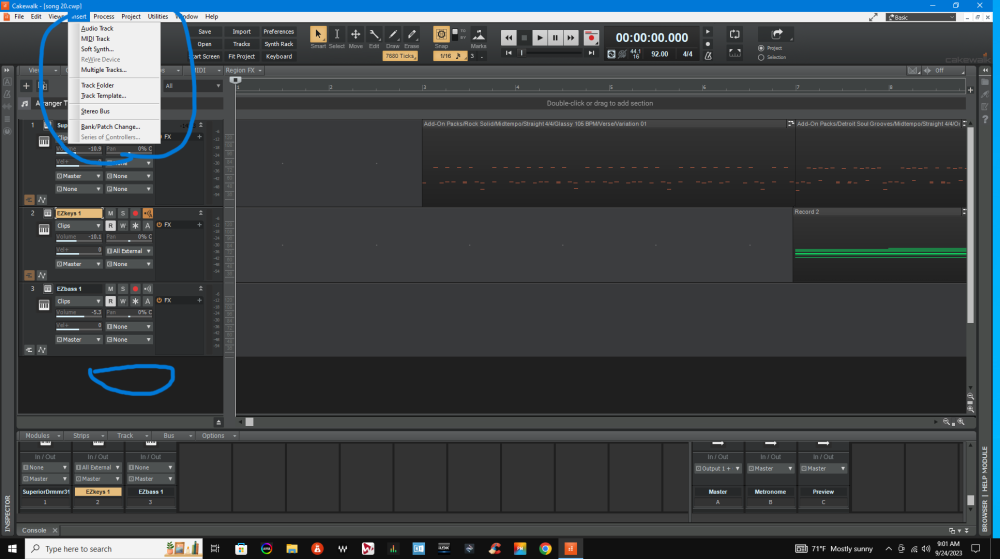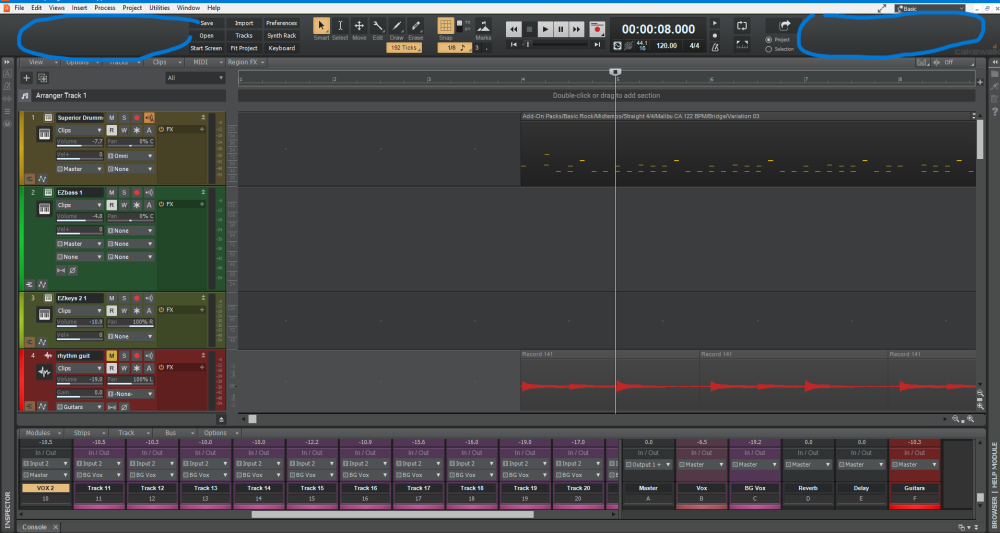-
Posts
392 -
Joined
-
Last visited
Posts posted by greg54
-
-
Thanks, Glenn. I don't use Waves plugins anymore because I don't want to lease plugins. But I will find an alternative. Thanks for your help!
-
 1
1
-
-
Great. Thanks!
-
You'll need to listen through headphones. In this song by John Lennon, you can hear the lead vocals coming out of both speakers like a stereo effect, as if he's singing it twice, one panned R and the other L, but he's not. I'm curious as to what technique he's using to get the vocals to sound that way. Does anyone have any ideas?
-
I set the workspace to Advanced. Then I right clicked on the left side under my tracks and clicked on "Insert Instruments." Then a box came up that allowed me to choose all my MIDI instruments. I found what I wanted and inserted it. It was easier the way it used to be, but at least I'm able to insert instruments.
Thanks, everyone, for you input!
-
 1
1
-
-
I just watched Mike Enjo's video of Workspaces. I will work with that and see what happens.
Thanks!
-
 1
1
-
-
I know little about CbB. I know enough to do what I do.
But changing workspaces - not sure what that means or how to do it.
I changed nothing. I only installed the latest update. The update changed everything.
-
I don't understand the workspace being set to Advanced or "none." How do you do that?
-
In the photo below, in the blue circle on top, you can see that there is nothing to allow me to insert something like Toontrack SD3 or EZBass or any other MIDI instrument.
in the blue circle on bottom, I right clicked on it to see if I could insert it that way. No. I can't insert any MIDI instruments. If I reinstall, I would have to uninstall CbB, and wouldn't I lose all the plugins and have to install them all over again? How would that work? (Hope I don't have to.)
-
I just upgraded to the last version of CbB. And when I went to insert a synth, there is nothing there to allow me to insert Toontrack's SD3 or any other synth. It used to be that when you clicked on Insert, you had an option to find the synth or instrument you wanted to insert. Not anymore. How do you do it in this final version ?
-
I tried the VX64, and it clicks and pops. So I won't be using it.
Thanks!
-
49 minutes ago, Lord Tim said:
Sonitus Gate to get rid of noise between phrases > Sonitus EQ to pre-shape the vocal > Sonitus Compressor to tame the peaks > Sonitus Mutiband with only band 4 enabled and tuned to clamp down on sibilance to act as a de-esser > Sonitus Compressor to level the vocal > final Sonitus EQ to shape the vocal sound.
Put all of those in a FX Chain Preset and you have an instant vocal channel strip, and you can even assign custom controls to each thing.
If you want saturation, drop that FX Chain Preset into the ProChannel FX Chain module and add Tube or Tape emulation.
Thanks, Lord Tim!
-
8 hours ago, Lord Tim said:
It *can* be useful in part of a chain (in fact, the reason it hasn't been removed entirely, I think, is because it was part of a lot of FX Chain Modules) and I do like the saturation and quick EQ, but the doubler is a bit ehhhh and, I agree, the de-esser is kind of rubbish. That said, it's definitely found its way into a lot of my mixes over the years - it's a handy tool to have in the arsenal.

I think there are other things I can use. If it's a little unstable at times, it's not worth using, to me. Thanks!
-
Good to know, Johnny. Thanks!
-
Great, thanks!
-
I was watching this guy on youtube, and he had some plugins in his Pro Channel that I can't find. I'm on the latest version of CbB. The plugins were: VX 64 Vocal Strip, the SSL EV2 Channel Stereo, the Pui EPQ1A, and some others. I looked under modules, but I can't find them.
At 7:47 in the video you can see these plugins. I don't know how to add them onto the Pro Channel.
-
Great, thanks!
-
-
If I will not be able to use my current version, then I will have to update. I hope I like it

Thanks, JohnnyV!
-
 1
1
-
-
Something I'm not quite understanding. When the new Cakewalk Sonar comes out soon, I know the updated free version will continue to function. But what I am unclear about are older versions. I have not updated in about 2-3 years, because the old CbB works really well for me with no issues as is.
And "if it ain't broke, don't fix it." My question is, will the older versions cease to work when the last update is given? Will only the newest version work? Or will the older versions work but just not have support?
-
I found the download at Plugin Boutique, reinstalled it, and it works.
-
 2
2
-
-
I dont know how to delete a thread. I think I may know how to reinstall it.
-
I recently purchased the SSL X-ValveComp. It requires an iLok account, which I have. I installed it, and it's in my iLok account and activated. When I scanned my plugins, it's not in there. I have the SSL folder in my Common Files, but the plugin is not in the folder. I contacted Solid State Logic, but they weren't helpful.
I don't know how to uninstall and reinstall with iLok, so I don't know what to do at this point. Suggestions would be appreciated.
-
Update: I bought the Slate VSX and got panels to make the room smaller. Both made a big difference.
When I checked my mix through VSX, I heard mistakes. I also heard reference tracks better so have been able get my mixes sounding better, closer to the reference tracks.
And when I listen to the songs through my monitors, the panels (I put blankets over them) bring the songs closer (if that makes sense) because the sound doesn't travel so far to the back of the room.
Great suggestions in here. These things may not be for everyone, but they really helped me. ?
-
 2
2
-
-
6 hours ago, Kevin Walsh said:
I've been using Slate VSX since version 1 and I love them. I also use them for most of my listening, which, as has been pointed out by others, really helps. I'm no professional mixer (or any other kind of professional when it comes to making music) but since I've had VSX it's been MUCH easier to put together a mix that I immediately find playable on my room stereo and in my truck and my wife's car. That's something I was unable to do before VSX.
One other thing; I've had a few problems with earlier versions of the headphones. Two pairs over the course of about three years broke. And every time, a simple email to Slate resulted in a message: "New phone on their way!" Slate has astoundingly superb customer service. The final pair I received are significantly better structurally, and I've had no problems since receiving those.
Enjoy your new VSX phones, you will be amazed at how effective they are.
I'm wearing my VSX headset now listening to Tom Petty's "Damn the Torpedos".
Bliss.
Good to know. Thanks!





adding reverb or delay to track through sends isn't working very well - SOLVED
in Cakewalk by BandLab
Posted · Edited by greg54
When I have a vocal or guitar track and want to add reverb or delay, I make a reverb or delay bus, and then add it to the track through sends. Then I could adjust the amount I wanted for that particular track.
But lately when I do that, there is hardly any reverb or delay on the track. And by that I mean, even though I turn the sends knob up, there is barely any reverb or delay on the track. So I added the reverb directly onto the guitar track, and there was a ton of reverb. But when I put it back onto the reverb bus and add it to the track through sends, there is hardly any reverb, even though I maxed out the reverb on the reverb bus.
Solutions?